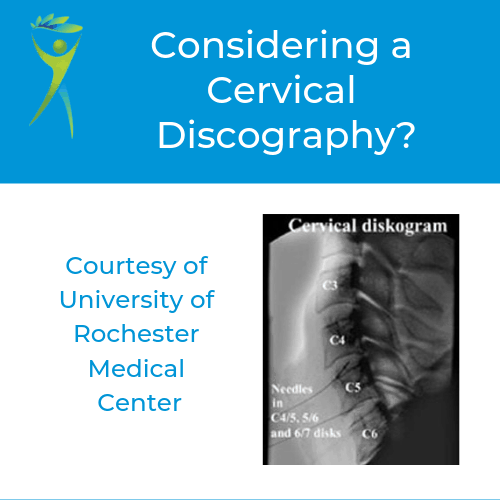
20 Mar Cervical Discography: Do I Have The Right Neck Pain Diagnosis?
Considering a cervical discography?
You’ve probably had more than 6 months of neck pain and you’ve already seen 3-5 other doctors or therapists, it’s so easy to lose hope.
If your pain lasts long enough and starts to get worse, you’ll inevitably entertain surgery.
Before scheduling the surgery, your orthopedic doctor may want to perform a cervical discography to confirm which disc is causing your pain.
Giving all of your trust to the first surgeon you see without thinking through your pain and problem leaves you open with risk of a surgery that not only doesn’t help your pain, but also, makes it worse!
To reduce any chronic pain, it’s VITAL that you have the right diagnosis.
How can you build a house (your end result) if all you think you need is a hammer (potential treatment)?
It’s common sense to identify nails (diagnosis A), screws (diagnosis B), and nuts (diagnosis C), and get a hammer (treatment A), screwdriver (treatment B), and wrench (treatment C) to get the outcome you want.
But when all you have is a hammer, everything looks like a nail. Just because you have ONE problem doesn’t mean their solution is going to help you.
Let’s see how we helped our patient Tom, who sought our help for his 10 out of 10 neck pain, after getting a cervical discography done and before getting surgery, realize that the diagnosis proposed by his orthopedic doctor was not correct.
What is Cervical Discography?
A cervical discography is a procedure used to diagnose which tissue is causing someone’s neck pain.
The practitioner will inject an x-ray dye into the disc and if the pain produced is exact same pain the person experiences in life at least at 70% intensity or at 7 out of 10 on the pain scale, this confirms the damaged tissue (in this case, a disc).
Below is an image, courtesy of University of Rochester Medical Center, showing an x-ray with needles being injected into discs.
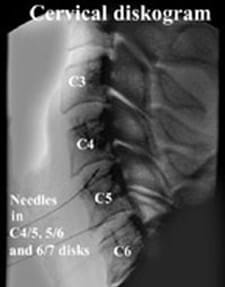
The problem with cervical discography is there is limited evidence suggesting diagnostic accuracy. Just because there is a lack of consensus on how to diagnose and treat chronic neck conditions does not mean we shouldn’t be collecting as much data as possible to come up with the best possible solution.
The discography may be helpful, but it’s not the end to the diagnostic process.
Fortunately for our patient Tom, we arrived at the correct diagnosis through a simple:
- history
- movement exam
- palpation
Meet Surgical Candidate Tom
Tom is a father in his 30’s who hasn’t worked in several years due to debilitating neck pain.
He was scheduled for surgery on his neck and decided to see if we could offer him some temporary relief (even though we offer PERMANENT, LASTING relief, like Tom would receive) at Barefoot Rehab.
Below, New Jersey’s Only Soft-Tissue Neck Specialist, Handsome Dr. Joe, and Clinic Director of Barefoot Rehab, Dr. Chris, discuss Tom’s case (13 minutes).
Tom was having neck pain with pain shooting into his whole hand.
Handsome Dr. Joe’s initial diagnosis was:
- Adhesion at the scalenes affecting the C6, C7, and C8 Nerve roots
You can see below:
- C6 covers the 1st and 2nd fingers.
- C7 covers the 2nd through 4th fingers.
- C8 covers the 4th and 5th fingers.
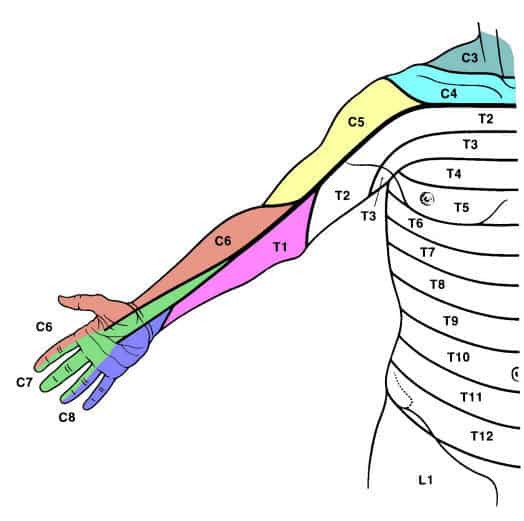
But the cervical discography was only done on the C5-C6 disc, which DOES affect the C6 nerve root. The pain Tom experienced was 10 out of 10.
There’s no question the C5-C6 disc is a problem.
What Handsome Dr. Joe discovered for Tom is the questions:
What about the C6-C7 disc?
What about the C7-T1 disc?
What is causing the nerve symptoms in the hand if those discs were clean on the MRI?
Handsome Dr. Joe proceeded to perform a cervical exam.
A Secret Problem in Tom’s Neck
One of our foundational principles at Barefoot Rehab is when it comes to pain coming from the musculoskeletal system, one of the first things that needs to be measured is your flexibility.
If you have neck pain and you can’t bring your chin to your chest, do you think that gives us valuable information?
Your measured flexibility provide enormous information.
We start every single neck patient with 5 neck tests.
- Chin Tuck Test
- Chin to Chest Test
- CT Flexion Test
- Cervical Rotation to Right
- Cervical Rotation to Left
The 5 neck tests tell you how healthy your neck is as each test is graded similar to blood pressure.
If your blood pressure is normal, you’re NOT at risk of heart disease.
If your blood pressure is high, you have higher odds of having a heart attack.
When your neck tests are healthy, you don’t have pain and you have very low risk of neck pain in the future.
But when your neck tests are failing, you have neck pain and it will get worse as time goes by.
Those 5 neck tests also tell you how much of the most common cause of pain that no one is talking about that you have.
It’s secret problem, kinda like glue in your muscles that causes your muscles to be tight and weak. It’s called adhesion.
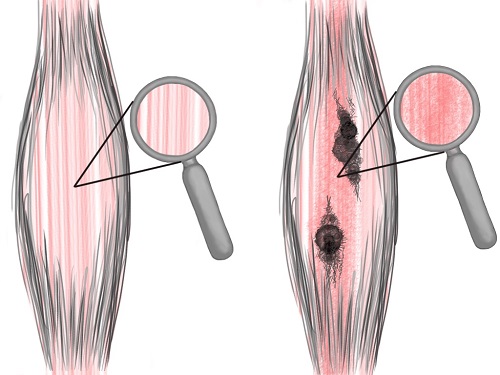
Now that you know what adhesion is, let’s dive into the tests.
The 5 Tests to Diagnose Someone’s Neck Pain
We use glasses and a level to measure the ranges. It’ll be hard to perform these at home. But going over the tests will give you context.
The chin tuck test tells us how much adhesion you have from the skull to C2 and if there is an inflamed disc or not.
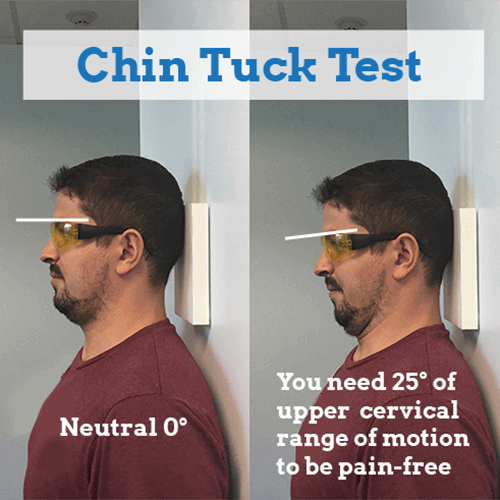
If you do this test and feel tightness or pain at the lower neck or down the upper back, you have an inflamed disc.
The chin to chest test tells us how much adhesion you have between C2-C7.
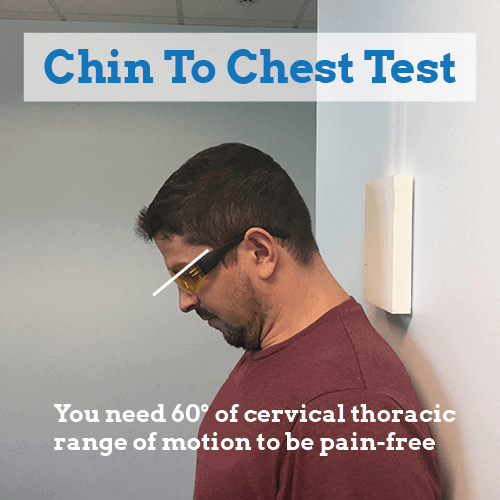
The CT Flexion Test tells you how much adhesion you have between C7-T6.
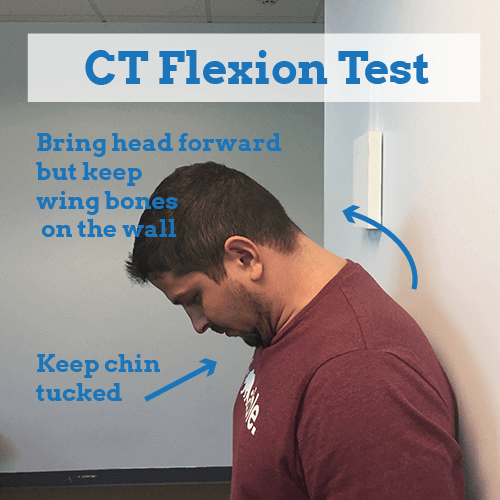
The Rotation Tests tell you how much adhesion you have in the deep rotational muscles between C4-T2.
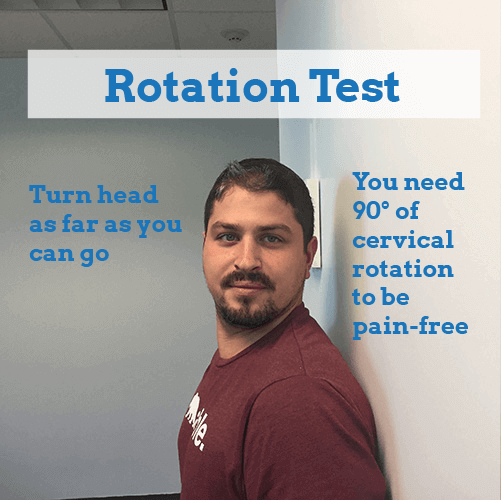
Handsome Dr. Joe did these 5 neck tests on Tom and felt his muscles for adhesion.
After performing the exam, Handsome Dr. Joe reworked the diagnosis to be:
- C5-C6 Disc Problem affecting C6 Nerve root (thumb and index finger)
- C6-C7 Disc Problem affecting C7 Nerve root (index to ring fingers)
- C6-C8 Disc Problem affecting C8 Nerve Root (ring to pinky finger)
- Moderate adhesion in his neck.
Tom is 40% Better after 6 Adhesion Removal Treatments
Remember, Tom had 10 out of 10 pain on a daily basis.
After 6 treatments to remove adhesion from his neck, his pain is at worst, 6 out of 10.
He’s ecstatic with his progress and even thinking about not needing surgery.
There are a few lessons you can gleam from Tom’s case:
- Ask lots of questions and make sure the diagnosis makes sense: Initially, Tom took the orthopedic’s word for it and didn’t ask any questions. After coming in to Barefoot Rehab and being offered a new perspective, he realized that his diagnosis was incomplete and he needed more information.
- Get multiple opinions: Remember doctors are humans. The best doctors have specialties where they know one area and defer to other experts to help fill in the holes. It’s smart to get multiple opinions from people in different specialties and judge those opinions based on what feels right in your gut.
- Get adhesion removed first: At Barefoot Rehab, we only take patients who have had more than 6 months of pain and have seen at least 3-5 other doctors or therapists without the lasting relief they want. We do NOT fix everybody, but we do help the majority of people who walk through our doors. Adhesion is the most common cause of chronic pain that no one is talking about. We highly recommend you get checked for adhesion before getting a cervical discography and potential surgery. You can find an Adhesion Provider HERE.
Think you might want our help?
Check out our over 100 5-star reviews on:
 If you’ve had a cervical discography, did it help lead you down having less neck pain? Or are you stuck with more pain down the treatment path you chose?
If you’ve had a cervical discography, did it help lead you down having less neck pain? Or are you stuck with more pain down the treatment path you chose?

No Comments